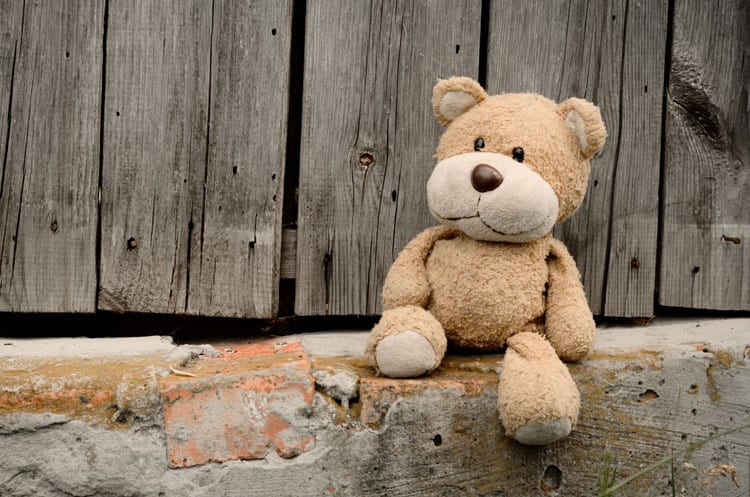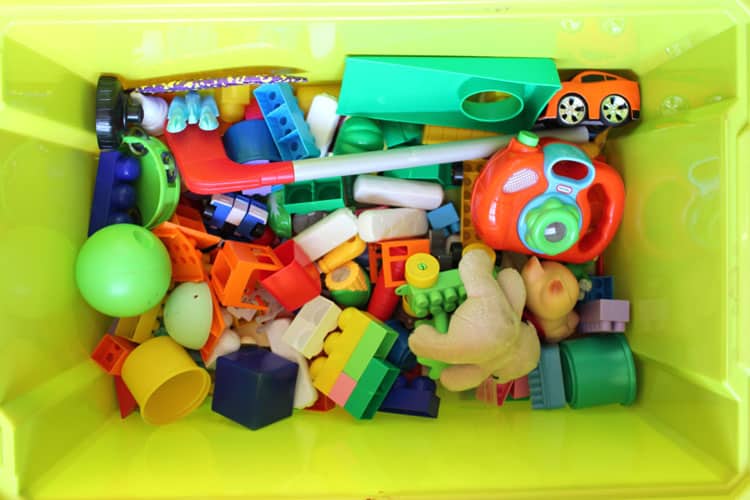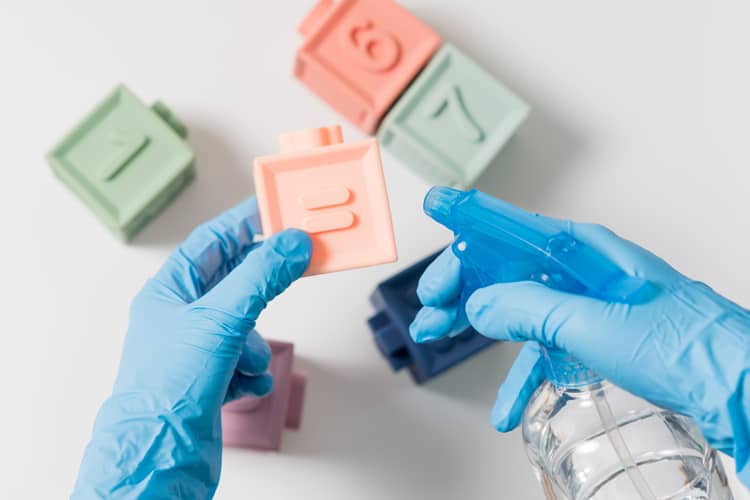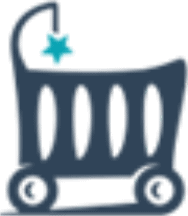Stuffed animals, plush toys, teddy bears and lovies are often a child’s best friend. Soft fabrics can easily and quickly pick up a host of dirt, germs and bacteria as children drag their little friends around. They commonly go in and out of the bathroom, outside to play, on daily outings in the car, to playdates or daycare, to bed when a child is sick and are repeatedly dropped on the floor.
Let’s discuss how to clean dirty toys properly without causing damage to your child’s favorite friend while keeping your little one safe. But first, some fun facts about dirty toys!
The Research on Dirty Toys

Research conducted by Dettol found several concerning facts regarding the beloved teddy bear. These stats will certainly have you questioning when the last time you cleaned your child’s dirty toys was!
- 80% of cuddly toys harbor bacteria that can trigger food poisoning
- One in four were found to be contaminated with feces (yes, poop!)
- 20% of teddy bears have NEVER been washed or thoroughly cleaned
- 66% were swabbed positive for staphylococcus aureus which is the main cause of skin and soft tissue infections
- 75% of plush toys do not get washed after a child has been sick
How to Deal with Dirty Toys

So, if your child’s soft toys are so contaminated, what should you do about it? There are two actions you as a parent can take (one more realistic than the other) when a toy gets saturated with snot or slobber, dragged to the potty seat during potty training or buried in the sandbox.
- Remove the toy from your child’s possession and clean it immediately. (We completely understand this isn’t realistic as a busy parent!!)
- Dedicate a plastic tub or a cardboard box (with a lid) specifically for dirty toys. When a toy becomes soiled in some way, have your child put the toy in the bin. If you can’t wash the toys right away, set them aside to wash later (we’ll teach you how to clean dirty toys next!) or schedule an appointment to have them cleaned by a certified cleaning expert—like the ones at BabyQuip Cleaning!
Related articles:
- How to Clean a Stroller Like a Pro
- Things You Can Teach Kids to Clean So You Don’t Have To
- What to Clean When Your Child is Sick
- How to Clean a Car Seat in 7 Easy Steps
How to Clean Dirty Toys Yourself

If you want to clean your child’s dirty toys yourself, we suggest following the steps below depending on the type of toy you need to clean.
Hard and Soft Plastic Toys:
These types of toys are relatively easy to clean and include things like figurines (dinosaurs, action figures, movie characters, etc.), Legos, bath toys, and any other item that doesn’t have fabric or electronic parts. Fill the sink with water and mild soap and submerge the toys for 15-30 minutes. After soaking, wipe with a soft cloth, rinse and let dry completely on an absorbent cloth or towel.
If the toys you wish to clean have holes in the bottoms (like squirting bath toys) you’ll want to make sure and squeeze the water/soap solution in and out of the toy several times. If the hole is large enough, you can use a pipe cleaner to help loosen and remove the gunk. Pro Tip: Look for bath toys without holes in them! This way you won’t have to worry about mold in your bath toys ever!
Look for a toy sanitizing spray that is safe for little ones and that doesn’t require rinsing. It’s another great way to clean dirty toys made of plastic.
Plush Toys:
Most plush toys (that are made of all fabric and stuffing) can be tossed into the washing machine with free and clear laundry detergent, if the manufacturer allows it, and then set to tumble dry on low to make sure any synthetic fabrics don’t get too hot.
If a plush toy specifically says not to machine wash we suggest following the BabyQuip cleaning process outlined below or spot treating according to the manufacturer’s directions.
Alternatively, you can fill your sink with warm water and ½ teaspoon of baby safe laundry detergent and hand wash the dirty toy. Let the dirty toy soak for 10 minutes. Then brush softly with a washcloth and squeeze out as much moisture as possible. Toss in the dryer on low (if allowed), set outside in the sun or place the toy in front of a fan.
Electronic Toys:
The best way to clean dirty toys with electronic parts or that are fully electronic is to wipe them down with a damp cloth. If they are really dirty, you can use a mild soap mixed with water as well. Just make sure to get all of the soap wiped completely off with a damp cloth. Do not submerge these types of toys unless you’re looking to finally rid yourself of that annoying musical toy that your child can’t get enough of, LOL!! While you are cleaning, it’s a good idea to change/check the batteries also.
Wooden Toys:
How to clean dirty toys made of wood is easy! Simply wipe all of the wooden surfaces with a damp cloth. If they get very wet, let them dry completely before letting your child play with them again.
What to Expect from a Toy Cleaning Service

BabyQuip Quality Providers are certified cleaning experts who know exactly how to clean dirty toys. Before beginning the process of cleaning any toy (plush, hard plastic or another material), they are first and foremost required to review the product manufacturer guidelines, instruction manuals and/or the label on the toy.
We use only the safest, most effective cleaning products/tools and follow a meticulous 5-step cleaning process for each and every toy cleaned. Items are vacuumed, cleaned, sanitized, thoroughly dried and carefully reassembled when necessary. Rest assured that when you use our baby gear cleaning services, your toys will be returned sparkling clean!
Vacuuming: When necessary for toys, we vacuum from top to bottom, inside all moving parts, hidden seams, covers, etc. to remove every last crumb.
Cleaning: We use a combination of water and mild detergent, or dye-free and scent-free soap (such as castile soap) to remove germs, dirt, stains and impurities from the toys. These types of cleaning agents safely clean fabrics and hard surfaces using surfactants to remove dirt, grease, and common bacteria and viruses.
Sanitizing: Quality Providers use steam cleaners or other tools to sanitize and remove a plethora of substances from fabrics, materials and plastics including: bacteria, viruses, urine, feces, vomit, grease, and other substances. We review all product manufacturer guidelines and follow their best practices for cleaning toys.
Drying: We are sure to soak up any excess water and moisture with microfiber cloths and then let the fabric dry completely. We often set items in the sun, outdoors, or in front of a fan to thoroughly dry.
Safe Reassembly When a toy has removable parts, we are careful to put all the pieces back together just right!
We hope this helps you on your dirty toy cleaning journey. How do you clean dirty toys or where do you get your toys cleaned? Tell us in the comments below. Any useful tips and tricks are also welcome!
Jennifer leads the marketing efforts at BabyQuip and is constantly trying to reinvent awesomeness through written copy, visual appeal, creative content & SEO. Jennifer is a mom of two boys and knows first hand the struggles of traveling with babies, toddlers and kids. When Jennifer’s head isn’t swimming with new marketing ideas you’ll find her tending to her backyard chickens and practicing meditation.



this is the biggest negative point of plush toys, they get dirty very easily thanks for sharing this article with us. Its really very helpful.
Hey, It’s very nice idea to write an article on this topic. I like your tips for clean dirty toys and will apply it surely. Thanks for sharing!
I have a problem with stuffed animals and trying to figure out what the recommended cleaning requirements are for each one…anyone know of an easy go to solution? I am more of the do it all the same way and hope for the best. Probably a good thing my child is not attached to any stuffies ;)
I was just gifted a bottle sterilizer, I wonder if I could use it for small toys!
Great tips!
Now I’m wondering how dirty all of the toys are in my house! Yikes!